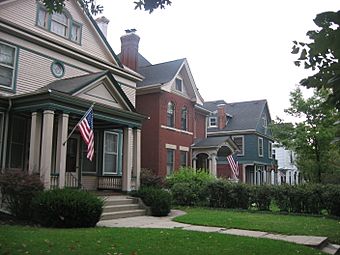Central Avenue Historic District (Dayton, Ohio) facts for kids
Quick facts for kids |
|
|
Central Avenue Historic District
|
|

Houses in the district
|
|
| Location | 201-338 Central Ave., Dayton, Ohio |
|---|---|
| Area | 8 acres (3.2 ha) |
| Architectural style | Late 19th And 20th Century Revivals, Late Victorian |
| NRHP reference No. | 82001476 |
| Added to NRHP | December 16, 1982 |
The Central Avenue Historic District is a special part of the larger Grafton Hill neighborhood in Dayton, Ohio. It's made up of just two blocks and has many houses built around the year 1900. This area is recognized as a historic site because of its unique past and well-preserved buildings.
Why Was Central Avenue Built?
Central Avenue shows how Dayton began to grow outside its original downtown area. Around the late 1800s and early 1900s, Dayton was growing very fast. This was because of a big increase in factories and businesses. Many people were becoming rich for the first time by investing in these new industries. They wanted to build new homes away from the busy city center. Central Avenue became a popular place for these families to live.
What Does the District Look Like?
The historic district has nineteen buildings. Eighteen of these buildings are considered "contributing," meaning they add to the area's historic feel. Only one building is "non-contributing," meaning it doesn't fit the historic style. Most of the buildings were built as homes for single families. They are located on both sides of Central Avenue, near where it crosses Federal Street. The district doesn't go more than one block from this intersection. Sometimes, Central Avenue is included in tours of the larger Grafton Hill neighborhood.
Architecture and Preservation
Central Avenue was built when the Victorian style was very popular. Many houses show Victorian designs, like the Queen Anne style. You can also find later styles, such as bungalows. Two of the most famous houses in the district, at 240 and 338 Central, are beautiful Queen Anne homes.
The buildings on Central Avenue have been kept in great condition. Because of this, the neighborhood was named a historic district. It was officially added to the National Register of Historic Places in December 1982. Since then, the area has become even more well-known. Community groups often organize walking tours to show off its history. Preservation Dayton, a local group, has even honored homeowners for restoring houses, like the one at 330 Central Avenue.



